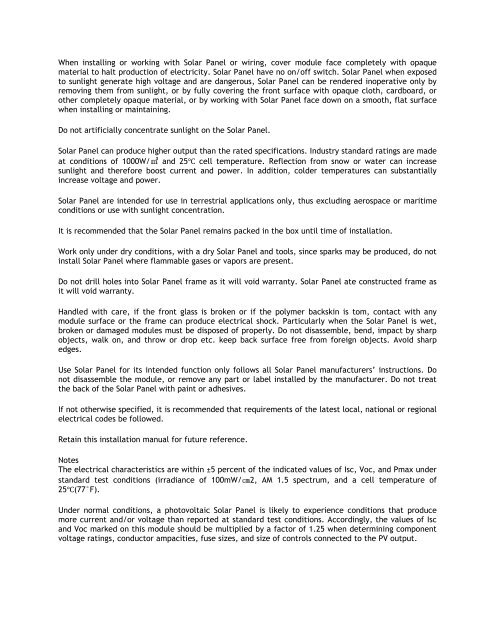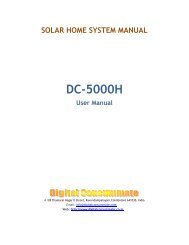How Do Solar Panel Work? A solar panel is a ... - Digital Consummate
How Do Solar Panel Work? A solar panel is a ... - Digital Consummate
How Do Solar Panel Work? A solar panel is a ... - Digital Consummate
You also want an ePaper? Increase the reach of your titles
YUMPU automatically turns print PDFs into web optimized ePapers that Google loves.
When installing or working with <strong>Solar</strong> <strong>Panel</strong> or wiring, cover module face completely with opaque<br />
material to halt production of electricity. <strong>Solar</strong> <strong>Panel</strong> have no on/off switch. <strong>Solar</strong> <strong>Panel</strong> when exposed<br />
to sunlight generate high voltage and are dangerous, <strong>Solar</strong> <strong>Panel</strong> can be rendered inoperative only by<br />
removing them from sunlight, or by fully covering the front surface with opaque cloth, cardboard, or<br />
other completely opaque material, or by working with <strong>Solar</strong> <strong>Panel</strong> face down on a smooth, flat surface<br />
when installing or maintaining.<br />
<strong>Do</strong> not artificially concentrate sunlight on the <strong>Solar</strong> <strong>Panel</strong>.<br />
<strong>Solar</strong> <strong>Panel</strong> can produce higher output than the rated specifications. Industry standard ratings are made<br />
at conditions of 1000W/ and 25℃ cell temperature. Reflection from snow or water can increase<br />
sunlight and therefore boost current and power. In addition, colder temperatures can substantially<br />
increase voltage and power.<br />
<strong>Solar</strong> <strong>Panel</strong> are intended for use in terrestrial applications only, thus excluding aerospace or maritime<br />
conditions or use with sunlight concentration.<br />
It <strong>is</strong> recommended that the <strong>Solar</strong> <strong>Panel</strong> remains packed in the box until time of installation.<br />
<strong>Work</strong> only under dry conditions, with a dry <strong>Solar</strong> <strong>Panel</strong> and tools, since sparks may be produced, do not<br />
install <strong>Solar</strong> <strong>Panel</strong> where flammable gases or vapors are present.<br />
<strong>Do</strong> not drill holes into <strong>Solar</strong> <strong>Panel</strong> frame as it will void warranty. <strong>Solar</strong> <strong>Panel</strong> ate constructed frame as<br />
it will void warranty.<br />
Handled with care, if the front glass <strong>is</strong> broken or if the polymer backskin <strong>is</strong> tom, contact with any<br />
module surface or the frame can produce electrical shock. Particularly when the <strong>Solar</strong> <strong>Panel</strong> <strong>is</strong> wet,<br />
broken or damaged modules must be d<strong>is</strong>posed of properly. <strong>Do</strong> not d<strong>is</strong>assemble, bend, impact by sharp<br />
objects, walk on, and throw or drop etc. keep back surface free from foreign objects. Avoid sharp<br />
edges.<br />
Use <strong>Solar</strong> <strong>Panel</strong> for its intended function only follows all <strong>Solar</strong> <strong>Panel</strong> manufacturers’ instructions. <strong>Do</strong><br />
not d<strong>is</strong>assemble the module, or remove any part or label installed by the manufacturer. <strong>Do</strong> not treat<br />
the back of the <strong>Solar</strong> <strong>Panel</strong> with paint or adhesives.<br />
If not otherw<strong>is</strong>e specified, it <strong>is</strong> recommended that requirements of the latest local, national or regional<br />
electrical codes be followed.<br />
Retain th<strong>is</strong> installation manual for future reference.<br />
Notes<br />
The electrical character<strong>is</strong>tics are within ±5 percent of the indicated values of Isc, Voc, and Pmax under<br />
standard test conditions (irradiance of 100mW/¡2, AM 1.5 spectrum, and a cell temperature of<br />
25℃(77°F).<br />
Under normal conditions, a photovoltaic <strong>Solar</strong> <strong>Panel</strong> <strong>is</strong> likely to experience conditions that produce<br />
more current and/or voltage than reported at standard test conditions. Accordingly, the values of Isc<br />
and Voc marked on th<strong>is</strong> module should be multiplied by a factor of 1.25 when determining component<br />
voltage ratings, conductor ampacities, fuse sizes, and size of controls connected to the PV output.



